BUILDING SMARTER
INNOVATIVE SOLUTIONS FOR A CLEANER TOMORROW






/cammediaedge
/cdnapartmentmag /mediaedgecam







/cammediaedge
/cdnapartmentmag /mediaedgecam
Canada is becoming a key region for real estate innovation, thanks to a growing tech ecosystem and influential real estate and construction sectors. According to a recent report from the Proptech Collective, four key trends drove innovation in 2023, catching the attention of proptech founders, real estate leaders, and VC investors, and ultimately influencing the types of products and solutions we are seeing more of on the market today. Trends include: Decarbonization, Affordability, Artificial Intelligence, and Integration & Consolidation.
In this issue, we explore all of these trends and more through the lens of what it takes to design, build, manage and maintain a successful multifamily apartment in 2024. From fuel switching and wireless HVAC, to drones and chat bots, you’ll find an array of timely information on the latest innovations impacting the rental housing sector this year and beyond.
We also showcase a variety of exciting new purpose-built rental projects that are changing the building landscape in Canada, including Hazelview’s new development on page 18 and Le Symbio Habitat on page 32.
We hope you enjoy the issue, and urge you to follow us on LinkedIn, Twitter and Facebook. Also, be sure to visit REMInetwork.com for daily news and articles impacting the commercial real estate sector.
All the best, and happy holidays!
Sincerely, Erin
Ruddy
Editor Erin Ruddy
Art Director Annette Carlucci
Graphic Designer Thuy Huynh-Guinane
Production Coordinator Ines Louis
Contributing Writers Nicole Harris
National Sales Jake Blanchard Melissa Valentini
Digital Media Director Steven Chester
Circulation Adrian Holland For sales information call (416) 512-8186
Canadian Apartment Magazine is published six times a year by:
2001 Sheppard Avenue East, Suite 500 | Toronto, Ontario M2J 4Z8 E-mail: info@mediaedge.ca President Kevin Brown
Group Publisher Sean
Subscription
Manufacturers:
of Circulation: Available from the publisher upon written request. Although Canadian Apartment Magazine makes every effort to ensure the accuracy of the information published, we cannot be held liable for any errors or omissions, however caused. Printed in
(Source: The Proptech Collective)







91 Pippin Road, Concord, ON L4K 4J9
91 Pippin Road, Concord, ON L4K 4J9
Tel: 905-660-2353 / 905-669-8888
Tel: 905-660-2353 / 905-669-8888
Toll Free: 1-888-660-2353
Toll Free: 1-888-660-2353
Fax: 905-660-8390 / 1-888-660-8390 sales@multitech2000.com
Fax: 905-660-8390 / 1-888-660-8390 sales@multitech2000.com






Ruddy
Nicole Harris
Erin Ruddy











Looking for a reliable partner to help bring your building project to life?



Look no further than Egis, formerly known as McIntosh Perry. With a staff of over 600 professionals and technical experts, we offer a comprehensive range of consulting engineering and technical solutions that cover all stages of a building project. From concept to completion, we work with you every step of the way to turn your possibilities into reality.





Trust Egis to help you achieve your building g oals with our full range of services for the building industry.




















Canada’s multi-suite residential property market continued to perform relatively well over the recent past, with demand outpacing supply and ensuring vacancy levels remained close to their all-time lows. Rental demand has eased slightly in recent months, now that the post-pandemic frenzy has tapered off. Still, the high cost of homeownership is preventing many Canadians from exiting the rental market.
“Despite the recent interest rate cuts, debt servicing costs remain high,” says Keith Reading, Director of Research at Morguard. “Rent growth has slowed from the double-digit increases of the recent past to more modest and sustainable growth levels. Market conditions are expected to be more balanced over the near term, as demand eases and new supply is delivered.”
Investment market
Investment sales activity has been relatively robust recently due to the availability of large-scale assets. According to Reading, investors continue to exhibit confidence in Canada’s multi-suite residential rental property sector outlook as 2024 winds to a close.
Source: Morguard

“Values have leveled off and buyers have been drawn to a sector with a healthy performance outlook,” he says, adding that several significant sales are expected to close before the end of the year, a trend that will likely continue into 2025.

Average asking rents for all residential property types in Canada fell by 1.2 per cent in October, marking the first annual rent decline since July 2021. According to Rentals.ca and Urbanation, this decline is mainly concentrated in the major urban centres of Ontario and British Columbia.
Toronto posted a significant 9.2 per cent annual decrease, bringing the average rent in the city to $2,642. Vancouver followed closely with an 8.4 per cent decline in October, averaging $2,945. Calgary and Montreal also reported declines, with rent growth down by 4.7 per cent and 2.9 per cent respectively since last October. Meanwhile, Edmonton recorded an 8.4 per cent increase, making it Canada’s most affordable large city at $1,584.
Shared accommodations continued their increase in popularity, with listings rising by 12 per cent month-over-month and 58 per cent year-over-year. Average rents for shared accommodation increased by 5.3 per cent in Quebec, 3.9 per cent in Alberta, 2.5 per cent in B.C., and 1.2 per cent in Ontario.





Coast to Coast monitoring
Considered a “One Ring” station No lengthy wait times
Considered a “True FSRC (Fire Signal Receiving Center)”
Most cost effective solution available
Big news, we now have two stations in New Brunswick and Ontario
We are fully bilingual

An accredited Call Center



Total housing starts in Canada’s six largest metropolitan areas rose by 4 per cent in the first half of 2024 compared to the same period in 2023. The level of new construction (68,639 units) was the second strongest since 1990; however, when adjusted for population size, housing starts were close to the historical average and not enough to meet growing demographic demand.
Calgary and Edmonton led the growth in all housing starts in Q1 and Q2 due to record interprovincial migration in recent years, driven by their lower cost for housing and favourable economic conditions. In contrast, housing starts decreased in Toronto, Vancouver and Ottawa.
Multi-unit starts in all six cities increased slightly during this period, driven by rental construction. Nearly half of the apartments started in the first half of 2024 were purpose-built rentals, representing the high-
est share on record. This trend aligns with demographic changes and declining homeownership affordability.
With the exception of Calgary and Edmonton, condominium apartment starts fell in the first six months of 2024, a trend CMHC expects will continue as developers struggle to reach the minimum pre-construction sales needed to start construction. Both investors and end users have significantly reduced their purchases of new condominiums because of the impact of higher interest rates.

After reaching record levels in 2023, purpose-built rental apartment construction slowed in Toronto and Ottawa and declined slightly in Vancouver. Meanwhile, Edmonton had the highest rate of purposebuilt rental construction, with 20 rental apartments started per 10,000 population. In Edmonton, rental supply is catching up with demand as developers respond to rapid rent increases driven by favourable economic and demographic conditions.
This is not the case in Toronto, where purpose-built rentals face increased competition from condominium apartments. Condominium completions and rental listings have risen, with investors choosing to rent out their units because of a soft resale market. In recent months, industry sources have reported a decline in asking rents for condominium units, with newly built purpose-built apartments tending to be priced similarly. CMHC surmises that slower rent growth in Toronto could make more purpose-built developments financially unfeasible.
Aside from Calgary and Edmonton, condominium developers in most cities have struggled to meet minimum sales thresholds for financing, especially for large projects. Throughout 2024, this led to delays and cancellations of new project launches. CMHC’s data suggests that
A new sustainable, transitoriented infill development at 30 Cleary Avenue in Ottawa has received the green light from City Council to proceed. The project is a unique partnership between Theia Partners, the First Unitarian Congregation of Ottawa (FirstU), and Ontario Aboriginal Housing Services (OAHS).
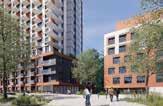
Odayanhaway (“Little Village”) will transform an underutilized parking lot adjacent to transit and the Ottawa River into an inclusive community for 200 individuals and families. The project aims to address Ottawa’s pressing need for affordable housing while setting a new standard in sustainability and community collaboration.
Odayanhaway will feature two distinct buildings: a 16-storey high-rise, jointly owned by FirstU and Theia Partners, featuring 148 affordable and “deeply affordable” units; and a 6-storey nonprofit building with 66 units, facilitated through a land donation from FirstU. Indigenous-owned and operated by OAHS, the building will be designed to provide culturally appropriate housing for Indigenous individuals and families.
Both buildings will adhere to strict environmental sustainability standards, demonstrating that affordable housing can also be sustainable housing. The project will feature innovative green technologies such as geothermal heating and cooling, and sustainable design practices to reduce the buildings’ carbon footprint.

projects that secured enough sales to proceed were, on average, smaller in size, with fewer units and storeys, than those launched in the first half of 2023.
Concern over the cost of housing in a slowing economy has shifted demand for new condominiums to lower price points in markets where prices were already high (Toronto) or have risen quickly (Calgary). In these markets, developers have been starting projects in less
“Housing
expensive areas (for instance, outside city centres) to address affordability needs and manage expenses. Factors like land prices, approval times, municipal policies and labour availability have become key considerations. Industry sources indicate that developers have been hesitant to lower prices for unsold units in existing projects, instead offering substantial incentives like free parking, waived maintenance fees and upgrades. To maintain acceptable profit margins, developers may face longer pre-sales phases, extended development times and potential project cancellations, leading to lower starts numbers in the future.
• Housing starts in Toronto during the first six months of 2024 declined compared to the same period in 2023. This decrease was led by a sharp pullback in purpose-built rental construction due to high financing costs and declining asking rents impacting the profitability of new rental developments. According to CMHC, a turnaround in housing starts “will require improved financial and macroeconomic conditions to encourage renewed confidence in consumers and developers.”
• Housing starts in Vancouver fell in the first half of 2024 as slow sales and high financing costs
For more information on housing starts in Canada, please visit the CMHC website
reduced profitability and increased risks. Rental construction continued to make up a growing share of new apartment builds, supported by government policies and incentives. Changes to provincial and municipal zoning policies aim to increase density and create more opportunities for future housing supply.
• Housing starts in Montreal picked up this year but wasn’t enough to effectively address the increase in housing needs. The population increased significantly, yet only 20 units per 10,000 population were started. More than ever, residential construction in Montreal is concentrated in the rental apartment market, a trend CMHC expects will continue.
Consider the following:
• Who will represent your best interests?
• Who will give your property maximum exposure?
• Who will deliver the highest value for your Property/Portfolio?
With over 35 years of experience, tens of thousands of units sold, and hundreds of clients represented, we have consistently delivered superior results. Through our local and national coverage, we create maximum exposure, ensuring maximum value for your property.
If you have an interest in purchasing Multi Residential Properties, we currently have a number of available opportunities.



Sales Representative (416) 815-2332 david.montressor@cbre.com
Tom Schuster Director Sales Representative (416) 847-3257 tom.schuster@cbre.com


The Neutral Group is a fully insured, full-service interior renovation general contractor. We specialize in multi-residential suite upgrades and common area renovations. Our innovative suite turnover process, dedicated project management staff and facilities produce outstanding savings with time and money.




On time and budget. Neutral Group has a proven track record.

















Neutral Group provides bespoke solutions to Individual clients needs Neutral group employees best in class products and services and ESG driven.



by Erin Ruddy
Energy conservation refers to the effort to reduce wasteful energy consumption as a means to advance sustainability, lower greenhouse gas emissions, save on utility costs and improve the built environment. While the goal to conserve energy isn’t new, pressures facing building owners to comply with higher standards have augmented considerably, as evidence grows about the impacts of fuel-burning on climate change.
Thank fully, there is far more data today—and available solutions—to support rental-housing providers as they embark on energy improvements at their buildings. But with an abundance of new technologies and best practices to choose from, confusion and hesitation may inhibit some wellintended landlords from taking proactive steps. In other words, things aren’t as straightforward as they used to be.
Recently, Bondi Energy Corporation hosted an event to showcase some of the latest smarttech products and shed light on incentives for multifamily building retrofits. From heat pumps for HVAC and water-heating, to integrated building control systems and products to improve distribution pipework efficiency,
the event put new technology on display and answered questions about funding, policies, and Canada’s changing building landscape.
“We are on a mission to increase energy efficiency in multifamily and commercial buildings across North America,” said Belinda Gilbey, CoFounder and President of Bondi. “Heat pumps have been proven to be the most efficient way to decarbonize buildings, while also reducing energy bills, introducing air conditioning, and improving air quality. In addition to heat pumps, we are also seeing some emerging new technologies that will greatly benefit apartment owners.”
According to Quinn McGovern, Director of Operations at Bondi, the benefits of embracing new technologies and strategies—fuel switching in particular—are impossible to ig-
nore, especially as more buildings undergo conversion projects, bringing an influx of supporting data to the forefront.
“Electrically heated buildings generally offer a bulletproof business case for HVAC heat pump retrofits, cutting heating bills in half while adding building-wide air-conditioning,” he said. “Fuel-switching the gas-heated building stock to use electricity is our next major priority. We have carefully analysed business cases for gas-heated multi-res buildings, which make up the vast majority of MURB building stock, and today we are focused on showcasing that data from research and from the field. I believe we can make a real difference supporting building owners with technology for improving their building stock and reducing GHG emissions.”
“Heat pumps have been proven to be the most efficient way to decarbonize buildings, while also reducing energy bills, introducing air conditioning, and improving air quality.”
Of course, every retrofit requires a financial investment, and substantial upgrades can be costly. Bondi recently launched a unique financial product available to property owners facing budgetary hurdles as a barrier-to-entry for many retrofit efficiency projects. Describing it as “a distinct way for owners to pay for building efficiency work while avoiding the capital expense,” McGovern said the financial product will help relieve some of the worry many property owners have about funding.
Speaking about the broader impacts of climate change, Peter Love, President of Love Energy Consultants Inc., addressed why it is incumbent upon apartment owners to invest in energy retrofits—especially in Canada, which is recognized as one of the worst global offenders when it comes to energy consumption.
“I am a big believer in continuous improvement,” he said. “Every positive change we make contributes as we strive for decarbonization and a net zero carbon economy. Most energy efficiency upgrades are invisible, so it’s important that multi-unit building owners celebrate them. This includes telling staff, suppliers, and residents about any energy improvements that have been made across the board.”
Love breaks out energy efficiency improvements into the following six categories:

1. Conservation behaviour – creating a culture among staff and residents that prioritizes energy efficiency.
2. System operations – effectively managing, maintaining and training facility operators on current systems, including HVAC commissioning/recommissioning.
3. Fuel substitution – switching to heat pumps or other alternative power sources to reduce carbon emissions.
4. New technologies – investing in smart, new tech solutions designed to improve efficiencies at the building.
5. Demand response – curtailing or reducing demand for electricity and water at peak times.
6. Onsite generation – incorporating “behind-the-meter” systems such as solar panels to create energy.
Essentially, by taking steps across these six areas, whether the plan includes making small energy-saving adjustments or investing in a solar array, Love said there are many ways to advance energy conservation without resorting to leveling the building.
“Awareness is by far the biggest barrier to increased energy efficiency,” he added. “Fuel substitution, for instance, is a form of energy efficiency that has become extremely important as we strive to attain a net zero carbon economy. Heat pumps aren’t all that new, but still, not
Flowmix, a Canadian-based hot water solutions provider, has developed a product to maintain the cycle of hot water in residential water delivery systems. This is good news for residents of high-rise apartments, where fluctuating temperatures, inconsistent pressure, and delayed delivery of hot water are known to elicit complaints. It’s also good news for multi-res property owners looking to reduce water waste and lower their monthly utility bills.
According to Flowmix field support technician Tanya Galea, the new control system is designed to be the primary domestic hot water temperature controller in a continuously pumped circulating hot water system.
“The design features a fail-safe shutoff valve with conservation capabilities during idle periods,” she said. “Residents in buildings equipped with Flowmix can expect reliable, consistent hot water, while management and owners can reap significant cost savings.”
Available for new construction or retrofit, the Flowmix Hot Water Control System is helping improve domestic hot water distribution in urban centres throughout North America.
For more information visit: flowmix.ca
enough building owners are tapping into their amazing benefits.”
Benefits include increasing the building’s value, reducing energy costs, introducing efficient cooling where it didn’t exist before, improving tenant comfort, and lowering baseline GHG emissions by up to 60 per cent. The technology works by using electricity to transfer warm and cold air rather than generating it by burning fossil fuels.
While executing a generational change to the heating system of a 50-year-old building may sound daunting, installing the units isn’t as invasive as it seems. According to Gilbey, “Heat pump technology has advanced tremendously, with little disruption to the tenants or the building façade. It’s a low-cost way to upgrade an aging asset at a time when the multi-residential sector urgently needs to pursue decarbonization.”
Energy savings and resident comfort aside, the state of our changing climate has greater implications. According to a recent report from the Building Decarbonization Alliance (BDA), buildings directly account for around 13 per cent of our annual greenhouse gas emissions yet change across the sector is happening far too slowly to meet Canada’s 2030 and 2050 emissions targets.

“The status quo is clearly not working,” BDA analysts wrote. “Heat pump sales in the next three years will need to more than double current projections to meet Canada’s climate goals.”
But to get there, Love acknowledges building owners need more clarity and support in terms of available programs and funding to incentivize fuel switching.
“With past programs, there has been a tendency from the utilities to make forms more complicated than they need to be, coupled with
policies and regulations that just aren’t clear,” he said. “There needs to be better messaging, better programs, and a simpler way for building owners to move forward.”
Meanwhile, building codes are changing to raise the minimum standards of existing buildings, and not just to ensure new buildings are constructed with lower emissions from the ground up. Apartment owners need to ramp up their energy strategies and invest in decarbonization if they want to stay afloat.









Modern meets vintage at Hazelview’s latest residential development

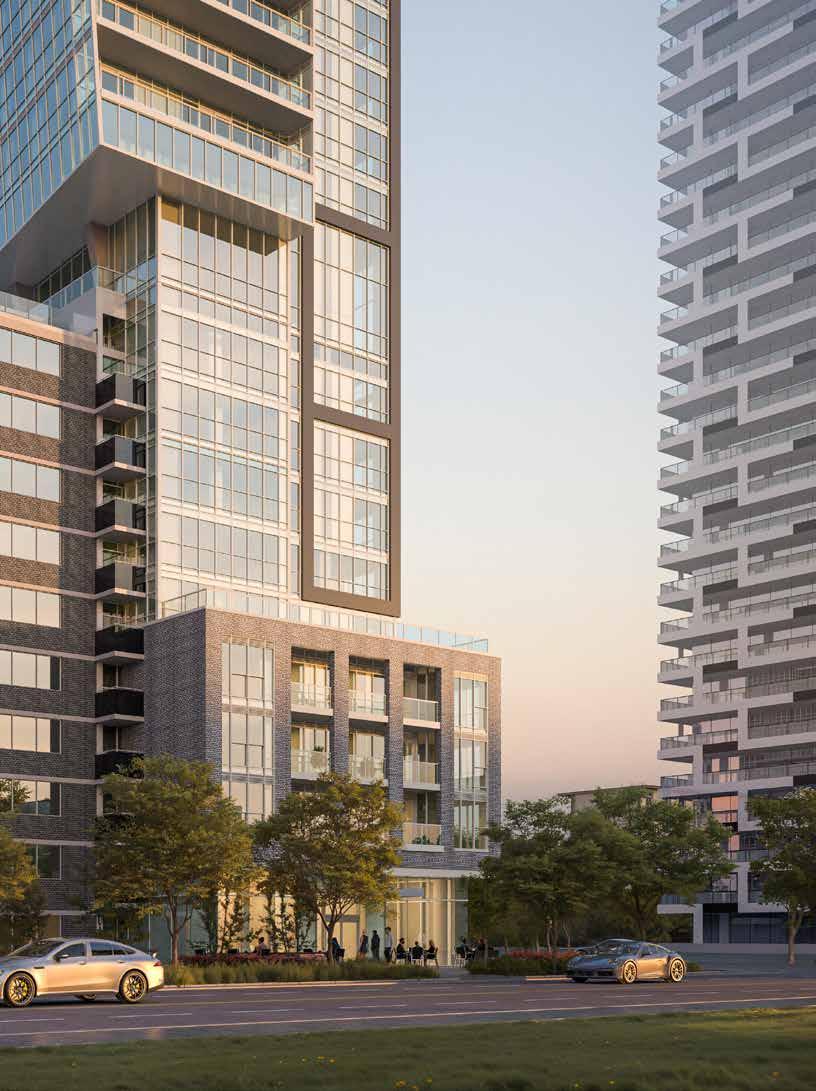
By Erin Ruddy
Hazelview has embarked on an exciting new plan to increase Toronto’s rental supply while simultaneously revitalizing an existing apartment building. Located at 73 and 75 Broadway Avenue, the project merges the old with the new, blending urban design with eco-friendly features in a landmark approach by the Canadian developer.
This project is significant for us because we see it as an opportunity to address two of our sector’s biggest challenges in one location,” says Colleen Krempulec, Managing Partner and Head of Sustainability. “First, we are building and adding much-needed rental housing on previously underutilized urban land, and second, we are decarbonizing an aging multifamily building, bringing the 10-storey, 1960s-era asset up to modern sustainability standards.”
The refurbishment at 75 Broadway, in conjunction with the construction of the adjoining tower, is expected to be complete by mid-2025. Plans include upgrading the existing building’s common area and fitting each unit with electrical pumps to reduce natural gas consumption. High-performance building envelopes, sustainable electrical distribution, EV charging stations and other decarbonizing measures will feature prominently at both sites.
“As a Canadian residential developer, this really is a groundbreaking effort,” Krempulec says. “Not only will we be increasing rental supply in the heart of midtown Toronto but decarbonizing and improving sustainability through measures that will reduce greenhouse gas emissions by 95 per cent, further contributing to the city’s sustainability goals.”
All told, the project will result in 520 energyefficient suites, 336 new and 184 upgraded. While some of the original tenants have remained in place throughout construction, occupancy at the new building is expected to begin in late 2025. The tenant base will likely include a mix of young professionals, couples, and starter families given the present demographics of the Yonge & Eglinton node. As such, a mix of unit sizes, from bachelors to three bedrooms, will be available.
Architecturally, this isn’t your standard multifamily high-rise built on the site of a former parking lot. The renderings depict a gleaming 38-storey tower soaring over its vintage neighbour in a bold and salient statement.
“We had to remove some of the west section of the existing 10-storey building, then we bolted on the new tower, which cantilevers over the top of the existing building creating a striking effect,” Krempulec says. “This approach allowed us to create bigger floor plates and optimize the space while minimizing the square
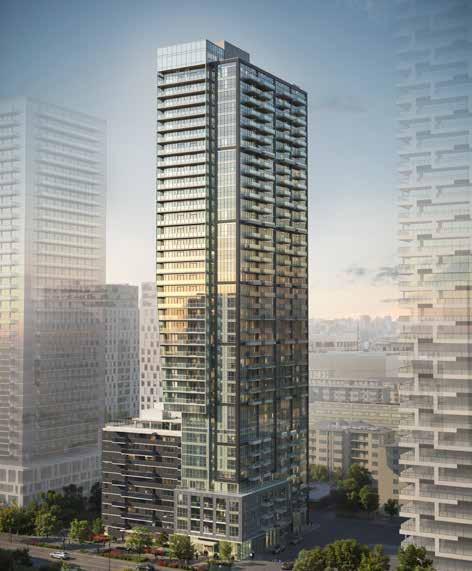
• A striking cantilevered façade spanning floors 10 through 22, maximizing square footage and living space while minimizing the building’s footprint.
• Over 15,000 square feet of shared amenities, including a fitness centre, co-working space, rooftop terrace, and lounges.
• A high-performance building envelope to facilitate climate control, sustainable electrical distribution, waste diversion, and a focus on sustainable transportation including EV charging stations and dedicated bike stalls.
• Mechanical and electrical upgrades, energy-efficient heating and cooling systems, and eco-friendly materials to improve air quality and reduce the site’s carbon footprint.
• Electric heat pumps at the existing building to deliver a 95% GHG reduction of the heating system, in addition to seeking CaGBC certifications for green building standards.
“Increasing density through infill brings more supply to areas people want to live, and does it with innovation at the forefront.”
footage on the ground. It’s the first time we have ever bolted two residences together, giving tenants a through-way between the structures so they can access the shared amenities, which are really comprehensive.”
Hazelview currently operates more than 23,000 rental units across Canada, with a large pipeline of new developments underway. This includes three towers at Bloor and Dufferin,, bringing another 1,000 rental suites to the city’s inventory in the near term. Like the infill project at 75 Broadway, Krempulec says Hazelview’s approach to optimize underused urban land while also creating a sustainable living environment is driving most of the company’s new developments.
“Increasing density through infill brings more supply to areas people want to live, and does it with innovation at the forefront,” Krempulec says. “We really feel that innovation and sustainability are central to everything we do, whether it’s upgrading an old asset or building something new. From a technology perspective, we are committed to investing in Buildtech, Cleantech and Proptech through our subsidiary, Hazelview Ventures. One of the benefits of this is that we get access to some of the leading-edge technologies that are coming to market to support sustainability and property management initiatives.”
Case in point: Hazelview recently piloted a new technology that utilizes drones to scan the exterior of a building and identify opportunities for energy improvements. From leakages to structural deficiencies, the knowledge gained in a matter of days can help building owners eliminate carbon emissions while reducing building maintenance and ownership costs. As Krempulec points out, this also eliminates the intrusive nature of building audits while speeding up access to important information about the building condition.
“All of this helps us continue to improve our current multifamily stock and attain our broader decarbonization goals,” she says. “We are always looking at new technologies and innovative ways to help us solve our challenges.”
New drone-based diagnostics tool helps accelerate the journey to net zero
A game-changing new technology is in development that leverages drones, thermal imaging, and AI-based analytics, to detect, diagnose and fix building envelope defects faster, cheaper, and more accurately than traditional methods.
Pioneered by startup tech company Lamarr.AI, a $1.1 million pre-seed funding round was successfully completed in October 2024, led by Hazelview Ventures and supported by other venture funds. The investment will allow Lamarr.AI to productize and scale this bleeding-edge solution designed to help building owners eliminate carbon emissions while reducing building maintenance and ownership costs.
“The interest from real estate companies in what we’ve built has been incredibly rewarding after perfecting the technology for nearly a decade in our lab,” said Tarek Rakha, CEO of Lamarr.AI and Associate Professor at Georgia Tech’s School of Architecture. “We are leveraging advances in drones, thermal imaging, and AI to autonomously detect building defects at scale, and with unprecedented accuracy. This innovation is enabling property owners to address faults before they become expensive headaches or environmentally unsustainable threats.”
The startup has already worked with numerous building owners and facilities managers to save more than $1M in engineering and construction costs by automatically identifying problems like deteriorated window seals and leaky roofs, in addition to helping effectively plan and scope large building envelope retrofits.
The use of novel AI to automate the analysis of thermal images captured by drones enables the company to provide actionable insights from building envelope inspections significantly faster, cheaper, and more accurately than manual audits. Further, the team can quantify the impact of defects on energy loss through whole Building Energy Modeling (BEM), allowing for ROI modeling that drives capex decision-making.
“We’re excited to lead Lamarr.AI’s first pre-seed round,” said Roger Poirier, Co-Founder of Hazelview Ventures. “We back startups that can directly drive value in Hazelview’s core real estate business. Lamarr.AI’s innovative inspection service has already had an impact on our operations and is an excellent example of the types of new approaches the industry needs to accelerate the journey to net zero in a financially sustainable way.”
For more information, visit www.lamarr.ai

Gas absorption heat pumps are relatively new to B.C. but have been used in Europe for space and water heating for more than two decades. Here’s what you need to know about this innovative technology:
1 They can operate at more than 100 per cent efficiency.


By using the evaporation and absorption of liquids to transfer heat, a gas absorption heat pump creates more than one unit of heat for every unit of energy it uses.1
2 They can maintain a comfortable space on the coldest days.
Gas absorption heat pumps are designed to operate efficiently in colder climates, even when temperatures drop below -40 °C.
3 They can be used in a variety of buildings.
These heat pumps can be suitable for a wide range of commercial, multi-unit residential and institutional buildings, like offices, hotels, care homes, recreation centres and more.
4 They can reduce GHG emissions2 with fewer upgrades.
Gas absorption heat pumps can use the gas equipment that’s already available in a building, like ductwork and piping.

5 They allow customers to choose their preferred energy source.
Gas absorption heat pumps can help reduce energy use, operating costs and associated GHG emissions for customers who prefer—or need to use—gas for space and water heating.
6 Gas heat pumps allow customers to further reduce emissions with Renewable Natural Gas. 3
These units provide an opportunity for customers to designate up to 100 per cent of their energy as Renewable Natural Gas (RNG) to help lower overall emissions further.

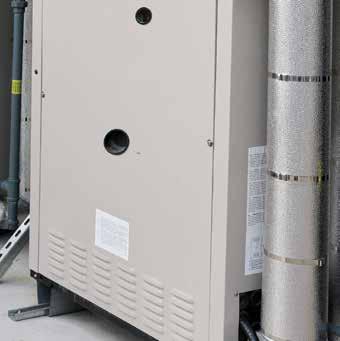
1Coefficient of performance (COP) and gas usage efficiency (GUE) results of more than 1.0 were achieved in a Robur A gas absorption heat pump system with dynamic controls, as recorded by Building Energy Solutions (BES) Ltd. in its measurement and verification report for the gas absorption heat pump pilot, phase three and four, September 9, 2021.
2When compared to standard-efficiency, 80 per cent annual fuel utilization efficiency, gas furnaces and boilers.
3Renewable Natural Gas (also called RNG or biomethane) is produced in a different manner than conventional natural gas. It is derived from biogas, which is produced from decomposing organic waste from landfills, agricultural waste and wastewater from treatment facilities. The biogas is captured and cleaned to create RNG. When RNG is added to North America’s natural gas system, it mixes with conventional natural gas. This means we’re unable to direct RNG to a specific customer. But the more RNG is added to the gas system, the less conventional natural gas is needed, thereby reducing the use of fossil fuels and overall greenhouse gas emissions.


*When compared to standard-efficiency, 80 per cent annual fuel utilization efficiency, gas furnaces and boilers. FortisBC Inc. and FortisBC Energy Inc. do business as FortisBC. The companies are indirect, wholly owned subsidiaries of Fortis Inc. FortisBC uses the FortisBC name and logo under license from Fortis Inc. (24-122.10 10/2024)
(up to 75 per cent of the total project costs) for energy-efficient gas absorption heat pumps in eligible commercial, multi-unit residential or institutional buildings.
Terms and conditions apply.
Not sure how this heat pump will integrate with your building’s existing systems? Eligible commercial customers can additionally receive up to $20,000 in feasibility study funding.
Learn how this innovative technology can help your business save energy and money, and reduce overall emissions.*
fortisbc.com/commercialheatpump Energy for a better B.C. Connect with us @fortisbc Up to $200,000 in


Building operations and their hardware components are undergoing a wave of digitalization, bringing added convenience, comfort, energy efficiency, and operational savings to building owners around the globe. As pressures to comply with sustainability regulations and the rising demand for energy efficiency encourage developers to seek out optimized Heating, Ventilation, and Air Conditioning (HVAC) strategies, innovative new solutions are emerging faster than ever.
According to the latest findings from ABI Research’s HVAC Systems & Hardware in Commercial Buildings market data report, HVAC equipment contributes between 38 and 70 per cent of a conventional commercial building’s energy consumption. While traditional HVAC systems have a binary function of ‘On & Off’, smart HVAC systems offer different modes to condition the air based on factors such as ambient temperature, occupancy, equipment scheduling, and energy consumption.
“Smart HVAC systems go beyond basic cooling and heating functions by bridging the connected and unconnected through intelligent climate control (temperature, air quality, and humidity tracking), remote management, proactive, predictive maintenance, and energy optimization,” explains Rithika Thomas, Senior Analyst for Sustainable Technologies at ABI Research. “Currently, over 75 per cent of the HVAC systems are hard-wired, but as awareness grows over the forecast period by 2030, adoption of wireless connected Smart HVAC systems will reach over 55 per cent.”
1. Wireless systems boost performance.
2. Wireless systems are easier to install than traditional HVAC systems.
3. Future upgrades are possible as the technology develops.
4. Wireless systems help reduce energy costs.
5. Digital HVAC control systems are more versatile.
6. Wireless systems enable predictive maintenance.
7. Users report “a better” overall experience.
8. Digital systems tend to be safer and more environmentally friendly.
Changing codes & regulations
Building codes and energy regulations are changing worldwide, stressing the need for the efficient use of HVAC equipment, low impact/sustainable refrigerant, and optimal set points to reduce energy costs. These changes are shaping the HVAC landscape
and putting a focus on refrigerant type and use, maintenance, environmental impact, and healthy indoor air quality.
“Maximizing energy efficiency in HVAC systems for commercial buildings is crucial to creating energy-efficient, sustainable, and comfortable built environments,” Thomas says. “Smart HVAC empowers occupants to control the temperature of a space on a granular level from dedicated devices, such as a digital dashboard or phone, to achieve thermal comfort.
Thomas adds that the upskilling of building operators, technicians, and installers on new digital and smart HVAC capabilities is critical to the success and implementation of connected HVAC systems. Once these skills are learned, however, the benefits will continue to unfold, with comfort, convenience, efficiency, and savings topping the list of reasons to adopt this budding new technology.
And the technology keeps getting better. According to the report, leading manufacturers of high efficiency HVAC systems are currently strengthening their offerings with Artificial Intelligence (AI), bringing low-frequency noise, efficient water use, smart control features, and enhanced cooling capabilities to their equipment. Meanwhile, small and medium enterprises digitizing building operations and Building Automation System (BAS) providers are partnering with established market players and commercial developers to prototype, manufacture, test, and deploy smart HVAC solutions in commercial buildings.
ABI Research’s HVAC Systems & Hardware in Commercial Buildings market data report is part of the company’s Smart Buildings research service.
Keep your residents happy with Coinamatic’s digital laundry room solutions.
Mobile pay and laundry card options
Unparalleled security
Fewer service calls, vandalism and theft
Visit smartlaundry.ca to find real time information on mobile account usage, machine availability, transaction information or report an issue.
Ditch the quarters and choose mobile pay! Visit or call to future-proof your laundry room today!



by Nicole Harris
As data breaches become more common, with malware and phishing scams happening at unprecedented rates, mitigating your organization’s risk while also having an effective communication strategy in place, are critical steps that every property manager should take seriously. Cyber breaches can result in financial losses, legal liabilities and reputational damage capable of crippling an otherwise successful organization. Sadly, these days, it’s not a matter of if, but when a data breach will occur.
Aside from working with an IT/Cybersecurity company to ensure measures are in place to limit risk and protect data, property managers should be cyber-ready with a cybersecurity communication plan developed in case of a data breach. Effective cybersecurity commu-
nication can be a powerful weapon to combat cybercrime, and it all starts with preparing for this unwanted incident.
3 steps for data breach readiness
To develop an effective data breach commu-
nication strategy, the first step is to prepare in advance by creating a crisis communication plan. This is a detailed document outlining the steps and responsibilities of the crisis communications team that must be adhered to during a cyber attack. The second step is to maintain
consistent, timely communication during and after the attack. The third step is to maintain full transparency throughout the crisis.
Key communication points
Following any data breach, your tenants and suppliers will want to know the following three things:
• Was my data stolen?
• What is my potential risk?
• Do I need to take action with any regulatory bodies, financial institutions and credit check agencies?
Every cyber crisis communication plan should provide accurate and timely information for addressing these questions. The plan should be communicated to all affected stakeholders by a crisis management team. Every person in the communication chain must report their findings to senior leadership so that all aspects of the breach can be considered and responded to appropriately. It’s also imperative to work closely with your com pany’s legal counsel to ensure a full understanding of your responsibilities with regards to regulatory bodies, government and insurance agencies.
Remember, time is of the essence. It’s best to inform all affected parties as soon as possible to ensure you maintain your position as the primary source of information. This helps prevent any misinformation from spreading from outside sources while reinforcing that you have everyone’s best interests at heart and are doing everything you can.
In order to communicate to tenants and suppliers which data was compromised and when the incident occurred, you’ll need to gather the following information:
• What happened?
• When did it happen?
• What are the known facts?
• What is the scope of the incident?
Remember that in the heat of the moment, it’s important for you to deal only in the facts and not wade into speculation about what may have led to the event and who is to blame. Transparency is key in any data breach. Impacted organizations should provide accurate and proactive information that is confirmed and approved by their legal counsel.
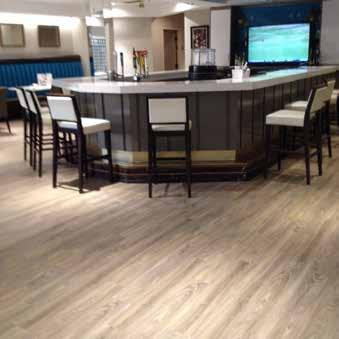
• How can we help tenants and suppliers?
In today’s fast-paced digital world, it is likely that every organization will fall victim to a cyber attack at some point, even with risk mitigation strategies and best practices in place. Having a carefully crafted data breach communication plan that focuses on clear, concise and timely communication in the event of an incident is a critical measure that will go a long way to maintaining the trust of all your stakeholders and the public.

Vinyl Plank Flooring Standard product line 5.5mm and 4.5mm SPC Click, 5mm Loose Lay and 2.5mm Dry Back, WPC (wood composite with cork backing), Carpet tile/Carpet plank. Details, colors, specifications, etc. please visit our website at www.traffixflooring.ca



Market, examines the long-term effects of population growth and other trends driving rapid rent increases across the country.
“We saw a lack of in-depth analysis of Canada’s housing crisis at the regional level and felt the need to address that,” said Aaron Pittman, Senior Vice-President and Head of Canadian Institutional Investments at Equiton, which commissioned the research. “While the housing crisis is an issue affecting all Canadians, Dr. Yönder’s AI-driven forecasts make it clear that a homebuilding approach that works in one region won’t necessarily work in another.”
New research released in October by the John Molson School of Business at Concordia University provides a fresh perspective on the future of Canadian rentals and housing affordability. The report, entitled AI-Driven Insights into Key Factors Influencing Canada’s Rental
The report predicts that rental rates will continue to experience significant increases in major cities like Vancouver, Montreal, and Calgary. Rental projections created using a neural network model indicate that rents in Toronto, for instance, will grow by 26 per cent by 2027 and by another 37 per cent by 2032 despite increase in supply.
For the full report, visit: https://equiton.com/key-factors-influencing-canadasrental-market.
Following the successful completion of “The Bowline”, GWL Realty Advisors is moving forward on another rental property in the Central Lonsdale area of North Vancouver. Plans for the six-storey development received unanimous approval by Mayor Linda Buchanan and City Councillors in July 2024, bringing 91 new rental units and a rich offering of amenities to the North Shore of the lower mainland market by 2027.
“This marks a significant milestone for this project and brings us one step closer to providing more housing in the highly walkable Central Lonsdale neighbourhood,” said Geoff Heu, Vice President, Development Western Canada. “North Vancouver is one of the strongest-performing rental nodes in the Metro Vancouver area. The rental rate growth is strong, and the vacancy rate remains consistently low. With excellent demographics and an aging rental stock, the fundamentals for a new building in this neighbourhood are compelling.”
According to Heu, the target market will include young professionals, seniors, and downsizers seeking premium, hospitality-themed rental accommodations. Amenities will include a tenant lounge, a fitness centre, and a children’s play area. “We are excited to embark on the next phase and see this development come to life,” he said.
Space and domestic water heating for the building will be provided by Lonsdale Energy Corporation (LEC), a municipally owned district utility. LEC uses a network of underground piping and mini plants to circulate hot water to heat to the buildings that are connected to its system. To cool the suites, a rooftop chiller will be connected to four-pipe fan coils.

“Each suite will also include energy recovery ventilation, which provides high levels of fresh air ventilation to the indoor space while recapturing heat from exhaust air before it is ejected,” Heu says. “It will be a well-insulated building, designed to exceed the BC Building Code Step 3 performance requirements.”
Construction is scheduled to begin in spring 2025.

The City of Mississauga, Lakeview Community Partners Limited (LCPL), Enwave Lakeview Corporation and the Region of Peel recently celebrated the groundbreaking of a new district energy project at Lakeview Village, a 177-acre, mixeduse development underway on Mississauga’s waterfront. District energy systems use a network of pipes to heat and cool an entire community from one centralized location, allowing for a combination of generation assets that work together to improve efficiency, consume less energy, and reduce GHG emissions.
The Region of Peel and Enwave are working to further decrease GHG emissions from the district energy system through a proposed plan to leverage treated wastewater, or effluent, from the nearby G.E. Booth Water Resource Recovery Facility as the main source of low carbon energy for the system. Once this transition happens, Lakeview Village’s residential units, offices and commercial spaces are expected to emit significantly fewer GHGs.
“This development is a complex undertaking, which will be the largest of its kind in North America with the integration of effluent and would not be possible without the determination and collaboration demonstrated by all partners,” said Enwave CEO Carlyle Coutinho.
Work is also underway for a new building that will house the district energy operations centre, which will be operated by Enwave, a sewage pumping station, which will be operated by the Region of Peel and an educational space to provide learning opportunities.


Leading rental website RentCafe recently published the Canadian Renter Interest Report, highlighting the cities that have captured the most interest in Q3 2024. To compile the list, analysts considered millions of interactions on its platform, specifically looking at four key indicators across Canadian properties: availability of apartments, listing views, apartments saved as favourites, and personalized saved searches. Here is a snapshot of the results:
1. Winnipeg, MB, leads as Canada’s top trending city for renter interest, with the highest possible score of 100 points driven by the high engagement metrics from renters. Winnipeg’s strong, diverse economy attracts apartment hunters from all over Canada, mostly from Toronto, Calgary, and Vancouver.
2. Saskatoon, SK, ranks second with a score of 90.49, driven by a 27 per cent increase in online traffic and a 34 per cent rise in favourited listings year-over-year. Interest for apartments in Saskatoon mainly comes from renters in Winnipeg, Calgary, and nearby Regina, SK.
3. Edmonton, AB, sitting at number three, stands out as the only major Canadian city in the top 10. With a score of 88.88, the city has the highest number of apartments marked as favourites. Edmonton attracts interest from young professionals and families, especially from cities like Vancouver, Toronto, and Calgary.
4. Victoria, BC, claims fourth place, driven by a 34 per cent increase in favourited listings and a 17 per cent rise in online traffic yearover-year. The city’s high quality of life and strong community appeal make it a favourite among renters from Toronto and within British Columbia.
5. Ottawa, ON, rounds out the top five with increased interest from government workers and young professionals looking for housing in the nation’s capital. Despite a slight drop in page views year-over-year, Ottawa ranks third for favourited listings, showing a strong, focused interest among apartment hunters.


The Lacey Green Village residential project is officially under construction in Kirkland, Quebec. Developers Prével and TGTA are promising a sustainable housing community with a mix of 950 condo units and rentals, 111 townhouses and 47 lots for single-family homes.
The site is located near the REM transit system on what is currently a vast field. The project pays particular attention to adapting the heights of the buildings for a balanced integration into the Kirkland landscape.
“Lacey Green Village is designed to foster connections across generations, encourage shared experiences, and provide an outstanding quality of life,” said Laurence Vincent, president of Prével. “In partnership with TGTA, we have poured our passion and expertise into this project to ensure that sustainability and residents’ well-being are part of everyday life. Watching this area become a hub of vitality and renewal for Kirkland is our greatest pride.”
Sustainable construction, efficient water management, the electrification of parking infrastructures and the profusion of greenery aim to enrich the daily lives of the residents.
“This launch represents a significant milestone in realizing our shared vision: to create a living environment that seamlessly blends sustainability, innovation, and harmony with nature,” added Martin Galarneau, associate at TGTA. “We are confident that this project will meet residents’ expectations and enrich the Kirkland community for years to come.”







The Building Operations Designation (BOD) Program is creating a new standard for the commercial real estate industry and Building Operations professionals through current, relevant, engaging, and interactive training content with ongoing insights and information through continuing education, special events and direct access to industry subject matter experts.


The BOD Program is online, self-paced and includes a robust, ongoing continuing education component. For more information, please visit BODProgram.com
























In tandem with the commercial real estate industry and over 450 recognized subject matter experts, we are proud to offer the BOD Program and its 22 certificates to all Building Operations professionals.


Over 2,900 real estate and operations professionals have already registered across Canada and many have attained various BOD Program certificate diplomas.





Proudly Developed and Delivered by:

If you and your staff are interested in registering for the BOD Program, please contact Chuck Nervick at chuckn@mediedge.ca or 416-803-4653.




Le Symbio Habitat, a newly constructed 29-storey rental building in the Montreal suburb of Terrebonne, is expected to become the first Canadian rental housing complex to earn both LEED and Zero Carbon Building (ZCB) certification, while also adhering to the criteria set out in the WELL Building Standard.
The 219-unit apartment complex opened its doors to its first residents in July 2024 after two years of construction and aims to achieve certification by July 2025.
“It’s a very efficient project in terms of energy,” said Guillaume Gélinas, Senior Partner at structural engineering firm L2C expertsconseils and lead engineer of Le Symbio, whose statement is supported by the results of a thermal analysis conducted by the firm Akonovia.
As per the findings, Symbio’s eco-friendly design resulted in a 42.3 per cent energy savings compared with a standard building
constructed to meet the National Energy Code. Active design measures at the site include central mechanical heating, high efficiency air conditioning and ventilation, and energy-efficient, longlasting lighting. Passive design measures feature high-efficiency aluminum framed windows and 12.7 cm of mineral wool insulation in the wall assemblies.
Notably, all balconies in the building are fitted with structural thermal breaks to achieve continuity of the insulated building envelope between the exterior balcony and interior concrete slabs. Meanwhile, the WELL Building Standard’s influence is evident in
Le Symbio’s abundant indoor natural light, optimized air quality, low-glare lighting, and enhanced thermal comfort.
According to lead architect Maxime Boily of ACDF Architecture, the goal was to create a design that was both energy-efficient and eye-catching: “It’s a tower. We don’t have a lot of towers in that area, so you can see Le Symbio from far away.”
With its compact floorplate, allowing for higher density on a smaller footprint, the building features 149 cantilevered balconies extending from the second to the 27th floor of the northwest façade, and from the third to the 28th floor on the northeast façade. Thermal bridging—caused when an uninsulated balcony slab or other cantilevered structure penetrates the building envelope—was a major concern given Montreal’s bitterly cold winters and humid summers, so the issue had to be addressed. As such, concreteto-concrete structural thermal breaks were installed on all balconies to reduce heat loss at the penetrations by up to 90 per cent compared to uninsulated, pass-through slab construction. According to the manufacturer Schöck North America, each structural thermal break consists of an insulative block penetrated by reinforcement bars that provide shear and tension strength. High thermal efficiency compression modules are distributed along the base of the structural thermal break for compressive strength. The units are placed at
the building envelope between the interior floor and exterior balcony slabs and are tied into the slab reinforcement before concrete is poured. In this manner, they provide insulation through the connection while supporting loads similar to conventional monolithic balcony extensions of the interior floor slabs.
Other features consistent with LEED and ZCB certification include easy access to public transit for tenants; pollution prevention initiatives undertaken during construction; the installation of high-efficiency windows and long-life LED lighting, and highefficiency plumbing fixtures to reduce water consumption. The building is well-positioned close to an abundance of businesses and amenities, public transit and green space, making it a hub for anyone wishing to adopt an active lifestyle while still enjoying the benefits of an urban neighbourhood.
Common areas for residents at Symbio include an indoor pool and sauna; a fitness room with state-of-the-art equipment; a yoga studio; a co-working space; and a rooftop terrace. The property also features indoor parking, garbage chute and compost and recycling facilities on each floor, bike storage and electric vehicle charging stations.
“The location of this building is really strategic, near two highways—the 40 and 640,” added Josée Lupien, president of Vertima Environmental Consultants. “There is also an opportunity in the area for another 1,000 residential units, helping address future housing needs.”

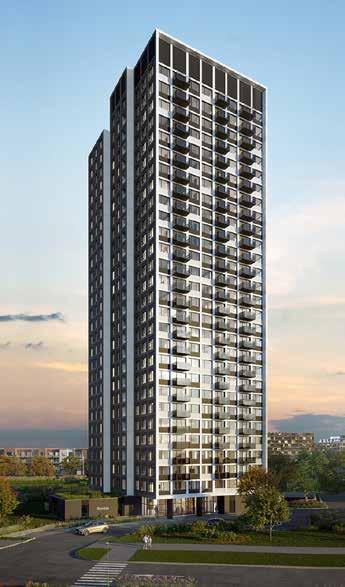
A Kitchener-based company is using AI to help property managers find qualified tenants for their vacant units faster. Called QuickCasa, the AI-based program reduces the amount of time it takes to research and respond to prospective tenant’s requests and queries.
QuickCasa’s AI model quickly answers questions about pricing, move-in dates, the lease agreement, access to amenities and other common inquiries. The added benefit is that by collecting this aggregate data, QuickCasa gains insights into what tenants are looking for, what concerns them, and what building features are important to them.
Founder Stephen McCabe worked with Conestoga’s Venture Lab, a business incubator that helps propel early-stage startups, to get this product off the ground. QuickCasa is currently managing the leads for 30 apartment buildings, with another 45 in the pipeline.
For more information, visit: www.quickcasa.ai

Certn is a screening platform built for “the dynamic needs of business.” Ranked 33rd on Deloitte Canada’s Technology Fast 50 of 2024 and 78th on Deloitte’s North American Technology Fast 500 in 2023, the BC-based company provides background screening and verification services for more than 20,000 global users, including governments, multinational corporations, and leading gig platforms.
Certn also offers a unique platform for rental tenant screenings.
“We’re on a mission to revolutionize the rental process, connecting property managers with trustworthy tenants,” the website says. “A new era of fast, secure, and reliable verifications is here, powered by the Certn Verifiable Credential Network (VCN).”
For more information, visit certn.co




































































































